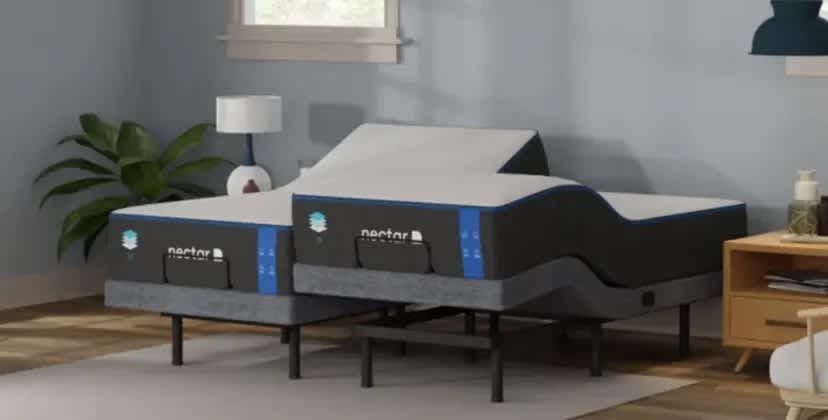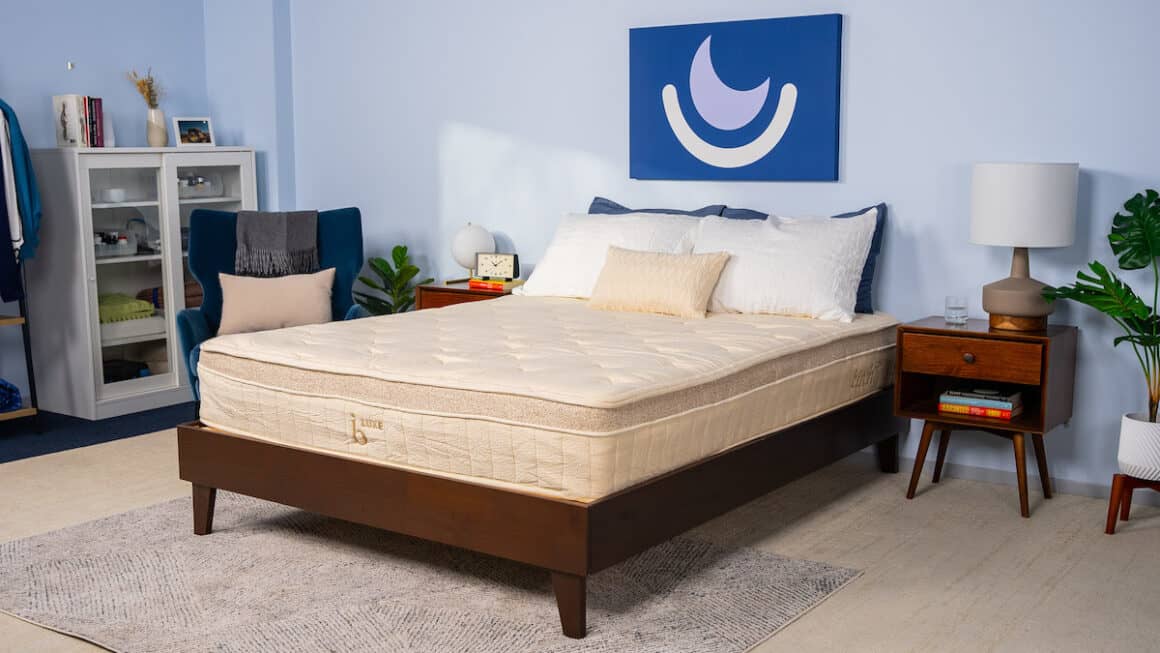On This Page
Best Mattress for Sleep Apnea of 2025
Top Picks From Our Testing Team
Our Top Picks
-
Best Overall Mattress
Solaire -
Best Value Mattress
Nectar Adjustable Bundle -
Best Firm Mattress
Plank Firm Luxe -
Best Organic Mattress
Birch Luxe
Best Overall Mattress

The Solaire Mattress offers the utmost in firmness flexibility, letting you dial in your comfort and support in any sleeping position. It’s made with high-quality materials, including organic cotton and natural latex, and it’s also backed by a 365-night sleep trial and a lifetime warranty.
Pros & Cons
Pros
- Firmness can be adjusted in the moment to match your body’s needs
- Organic cotton cover and natural latex certified by the Rainforest Alliance
- Multiple components designed to help you sleep cool
Cons
- Returns are assessed a $99 processing fee
- Springy latex layer can cause some motion transfer across the mattress surface
Ratings
Our Take
Best Value Mattress

The Nectar Adjustable Bundle gives back sleepers everything they need to elevate their upper body during sleep, which may reduce symptoms of sleep apnea. With both a basic bundle and options to upgrade, this set of products can fit the budget and sleep needs of a wide range of shoppers.
Pros & Cons
Pros
- Create-your-own bundle with choice of six mattresses and two adjustable bases
- Preset anti-snore setting
- Firmness level and contouring work well for people trying out side sleeping to combat sleep apnea
Cons
- Nectar Memory Foam Mattress may not feel firm enough for stomach sleepers
- Conforming foams in the comfort layers can reduce edge support
Ratings
Our Take
Best Firm Mattress

The Plank Firm Luxe is a reversible mattress that is firm (7) on one side and extra firm (9) on the other. With a coil support core for added bounce, the Plank Firm Luxe is a match for many back and stomach sleepers and people who want plenty of pushback from their mattress.
Pros & Cons
Pros
- Reversible design with firm (7) and extra firm (9) sides
- Impressive support for sleepers over 230 pounds
- Minimal heat retention reduces risk of waking up in a sweat
Cons
- Feels too firm for many sleepers, especially side sleepers under 130 pounds
- Limited motion isolation can lead to sleep disruptions from a bed partner’s movement
Ratings
Our Take
Best Organic Mattress

The Birch Luxe is a hybrid mattress featuring eco-friendly latex, wool, and cotton along with a sturdy support core of pocketed coils. Our team found that it offers a comfortable blend of bounce, pressure relief, and spinal support that meets the needs of the majority of sleepers.
Pros & Cons
Pros
- Made with sustainable and durable materials
- Hybrid design delivers strong performance for back, side, and stomach sleepers
- Temperature-regulating materials help the mattress sleep cool
Cons
- Bounciness can lead to motion transfer across the mattress
- Sleepers under 130 pounds may experience pressure points
Ratings
Our Take
Compare Our Top Picks
| Mattress | Mattress Type | Ideal For | Value | Sleep Trial |
| Solaire | Airbed | Couples | Good Value | 365 Nights ($99 Return Fee) |
| Nectar Adjustable Bundle | Foam | Couples | Great Value | 50 nights |
| Plank Firm Luxe | Hybrid | Heavy Sleepers | Great Value | 120 nights (30-night requirement) |
| Birch Luxe | Hybrid | Hot Sleepers | Good Value | 120 nights (30-night requirement) |
Can a Mattress Help With Sleep Apnea?
Choosing the right mattress may help with sleep apnea even if it can’t eliminate the condition. Sometimes sleep apnea emerges as a consequence of your sleep posture, and a better mattress can help modify your sleep position.
For example, an adjustable base allows you to raise your upper body during the night. Some research has shown that this can prevent your airway from narrowing, which is what leads to breathing disruptions in obstructive sleep apnea.
That said, sleep apnea is a serious condition and requires carefully chosen treatments. Your first step should always be consulting with your doctor about what will help the most given your particular profile.
Tips for Sleeping Better With Sleep Apnea
Some practical tips may help if you’re trying to get a better night’s sleep despite sleep apnea. But remember that this isn’t meant to be taken as medical advice, and you should never alter your prescribed treatment without talking to your doctor first.
Talk to Your Doctor About Treatment
Working with your doctor or a sleep specialist can go a long way toward improving sleep apnea. Your doctor can review different treatments and, if one doesn’t work, direct you to another option.
Your doctor can also help you get the most comfort and effectiveness out of your existing treatment. For instance, if you have a continuous positive airway pressure (CPAP) machine, your doctor can help you troubleshoot some of the most common CPAP side effects.
Try Sleeping on Your Side
Sleeping on your back can lead to or exacerbate obstructive sleep apnea for some people, so most experts recommend sleeping on your side instead. When lying on your back, gravity pulls tissue into your airway, which makes breathing disruptions more likely.
Switching your sleeping position can be a challenge, but a few tips and tricks may help:
- Using extra pillows to bolster or prop yourself into a comfortable side-sleeping position
- Buying a commercial device that you wear on your neck that vibrates if you start sleeping on your back
- Sewing a tennis ball into the back of a shirt that you wear during sleep
Sleep With Your Head Elevated
Sleeping with your upper body elevated changes the positioning of the tissue around your airway, and this may help address obstructive sleep apnea. Some ways to prop up your upper body include:
- An adjustable bed frame
- Multiple high-loft pillows underneath your head, neck, and upper torso
- A firm wedge pillow that slides under your torso
- Wood blocks or other products that go under the two legs at the top of your bed
Consider an Adjustable Bed
One of the easiest ways to elevate your upper body is with an adjustable bed frame. With the touch of a button, you can raise the top part of your bed to a comfortable incline that helps mitigate breathing disruptions when lying on your back.
If you’re considering an adjustable bed, make sure that you also have a compatible mattress that won’t be damaged by the movement of the frame.
What Is the Best Mattress Firmness for Sleep Apnea?
There’s no single firmness level that is best for everyone with sleep apnea. What feels most comfortable is subjective, and it’s important for every person with sleep apnea to find a mattress that feels right.
For some people with positional sleep apnea, switching from back sleeping to side sleeping can reduce breathing disruptions. To keep the spine aligned when side sleeping, a soft (3) to firm (7) mattress is usually best.
Optimal firmness means your mattress provides enough cushioning for pressure points without excess sagging. Finding this balance requires accounting for sleeping position and body weight. In general, side sleepers and people under 130 pounds need less firmness than back sleepers, stomach sleepers, and people who weigh over 130 pounds.
| Weight | Side Sleepers | Back Sleepers | Stomach Sleepers |
| Less than 130 lbs. | Soft (3) to Medium (5) | Soft (3) to Medium (5) | Medium Soft (4) to Medium Firm (6) |
| 130 to 230 lbs. | Medium Soft (4) to Medium (5) | Medium (5) to Firm (7) | Medium (5) to Firm (7) |
| More than 230 lbs. | Medium Firm (6) to Firm (7) | Medium (5) to Firm (7) | Firm (7-8) to Extra Firm (9) |
How Sleeping Position Affects Sleep Apnea
Back sleeping is the worst position for obstructive sleep apnea, and side sleeping is regarded as the best. As soft tissues in the throat naturally slacken during sleep, they are more likely to block the airway if you are lying flat on your back.
In some people, back sleeping can be a driving factor of obstructive sleep apnea symptoms. For that reason, doctors and sleep specialists often suggest that back sleepers try to switch to side sleeping. However, changing sleep positions alone may not fully resolve sleep apnea.
Video: Best Alternatives to CPAP Therapy
There are a few alternatives to using a CPAP machine that you might find helpful, though it’s important that you talk with your doctor before ditching a CPAP machine altogether. Join our sleep expert as he explores some of the alternative methods for reducing the symptoms of sleep apnea.
Discover More Mattress Solutions
If you want to find out about other top mattresses in a range of key categories, check out our mattress buying guides.
More Mattress Guides
How We Test
We follow a detailed methodology to pick the best mattresses in every category, including the best ones for sleep apnea. Testing is carried out by our team members who have extensive experience with sleep products and a range of comfort preferences, body shapes, and sleep positions.
Along with feedback from our team, we take objective measurements that help us know how well a mattress relieves pressure, absorbs motion, and dissipates heat. We take all of this information into account when deciding which mattresses stand out.
Frequently Asked Questions
Because it impacts your sleep posture, a mattress can affect sleep apnea. When sleeping on your back, it’s easier for the airway at the back of your throat to be obstructed, which may cause more pauses in breathing for someone with obstructive sleep apnea. Choosing a mattress that enables side sleeping or using an adjustable bed frame may help prevent these airway obstructions.
The best mattress for obstructive sleep apnea is one that supports your body when side sleeping. If it isn’t possible to stop sleeping on your back, a good option is a mattress that is compatible with an adjustable frame that lets you easily elevate your upper body.
The best mattress for you should also contribute to your spinal alignment and overall comfort.
Studies suggest that it’s better for back sleepers with obstructive sleep apnea to keep their upper body elevated. When lying flat, it’s more likely that the airway will collapse and cause apneas, which are temporary pauses in breathing.
Side sleeping is generally regarded as the best position for sleep apnea, because of how it maintains the alignment of the tissue around the airway. Stomach sleeping is also considered more favorable than back sleeping. For many people with sleep apnea, switching away from back sleeping can significantly reduce breathing disruptions during the night.
